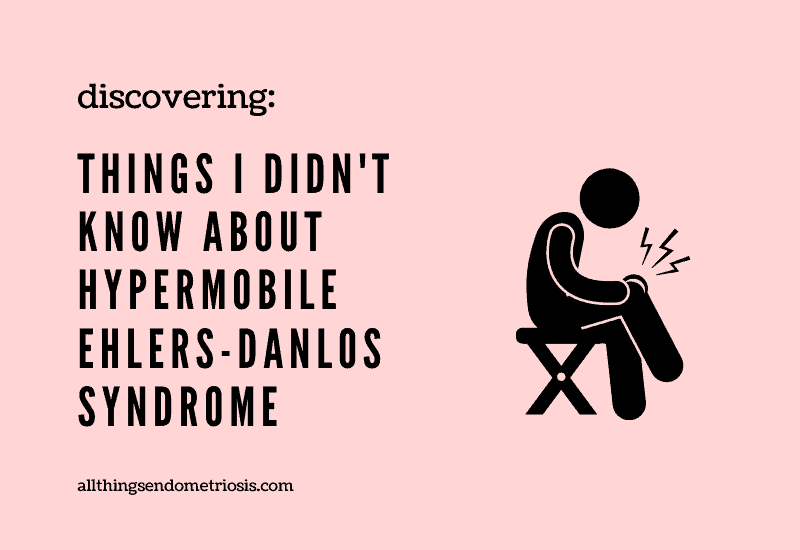
Having Ehlers-Danlos syndrome means having a complicated condition. I didn’t realise how complex it could all get and the extent it can affect an EDSer’s existence. If you’ve been newly diagnosed with it then these learnings of mine may help – well, I hope they do!
If you would like to watch a video version of this blog post then you can right here. But if you prefer to read, then scroll through 🙂
I had a major health crash because of hypermobile Ehlers-Danlos in October 2015 which left me visibly disabled. It took 18 months before I was diagnosed with EDS after a string of misdiagnosis and having to take steroids for my pain.
Relevant read:
- My Journey: Being Diagnosed with Ehlers-Danlos Syndrome
- My Experience: Treatments to Manage Ehlers-Danlos Syndrome
- How I Accepted My Mobility Aid
But that was five years ago.
In these five years I’ve constantly been surprised by how much I don’t know about EDS despite all that I’ve read up, all the questions I’ve bugged my doctors with and all that I have experienced.
I thought it would be good to create a list of things I didn’t know about hypermobile-EDS and sort of learnt the hard way.
1. Growing pains aren’t growing pains!
I was around 9 when I started going to the GP complaining of knee pains and was always dismissed as me experiencing ‘growing pains”. My discomfort was never taken seriously. Instead I was given ointments and told to apply bandages to help ease the pain.
What tops the madness of not being taken seriously was when an orthopaedic couldn’t figure out the reasons for my pain (other than believing I have growing pains), and eventually decided to perform an arthroscopy and removed a plica from my knee which wasn’t even needed!! Hmmppfff!!!
I wasn’t given the proper rehab I needed to gain strength and I carried on life believing I’m wrong in thinking that my pains were something else.
But years later, well just a couple of years ago, I got to know that a lot of people who were eventually diagnosed with EDS had their pains dismissed as ‘growing pains’ when they were younger. It’s one of those early signs of having EDS!
And now I feel that orthopaedic should have known better.
2. Connective tissue is everywhere, pain can happen anywhere
Ehlers-Danlos syndrome is a connective tissue disorder, and guess what connective tissue is everywhere!
What is connective tissue?
As explained by National Cancer Institute
“Connective tissues bind structures together, form a framework and support for organs and the body as a whole, store fat, transport substances, protect against disease, and help repair tissue damage. They occur throughout the body.”
So when a doctor told me that EDS is a group of connective tissue disorders – actually, I lie – a doctor never explained any of it, they just told me the name of the condition.
So when I read up that EDS is a group of connective tissue disorders, it didn’t quite register that connective tissue is everywhere!!
And so it didn’t quite register that I could possibly face issues in multiple places, rather than it just affectings my legs, arms, fingers and other organs. I didn’t really know how extensive the issues with my tissues could go.
Soon I had problems with my jaw, shoulder, neck…
View this post on Instagram
3. Leads to additional comorbidities
O’ boy this was a big one! I never thought so many of my other issues like endometriosis, fibromyalgia, chronic fatigue syndrome, dysautonomia (POTS) were all connected with Ehlers-Danlos!
I saw them as individual conditions, and strangely, so did my doctors.
Whereas, logically, it’s one body so it all must be connected right?!
I wrote about the EDS connection with all these conditions right here… but what surprised me the most is how such blatant connections were never picked up in my long history of visiting doctors.
The Connections:
- Connecting Endometriosis and Ehlers-Danlos Syndrome
- Are Ehlers-Danlos Syndrome & Fibromyalgia Connected?
- The Relation Between Endometriosis / EDS and Chronic Fatigue
- Dysautonomia: How POTS Changed My Life
4. Slow healing
When connective tissue is troubled, as it is when you have Ehers-Danlos syndrome, the issue of slow healing comes up.
I could never understand why the smallest of things would cause injury and then take such a while to go. I think the scariest moment for me was when an EDS specialist doctor was against me getting endometriosis excision surgery. She feared that I wouldn’t heal well, the tissues wouldn’t repair fast enough and that it could cause internal bleeding.
This really scared me as well.
But I took a chance and went ahead with my surgery a few years after being told this. The surgery was done by a doctor who had performed the excision surgery on EDS patients before and understood how to tackle the surgery better.
This also meant that I had a much longer recovery time, but knowing that I am a slow healer made me more cautious and got me mentally prepared to rest it out.
Relevant Read:
- How to Prepare for Endometriosis Excision Surgery
- What to Expect After Endometriosis Excision Surgery
- One Year On From Endometriosis Excision Surgery
- Everything Endometriosis
5. Just because you’re hypermobile, doesn’t mean you don’t need to stretch
Being hypermobile means, your joints can hyper-extend – as in move beyond the normal range of motion. This also means that people with hypermobile-EDS are more flexible.
I was pretty flexible growing up, doing gymnastics and yoga with ease.
But going beyond your range can cause flare ups which I have wanted to avoid, so I stopped stretching believing that I’m flexible any way, I’m well stretched any way.
This is so wrong.
Just because I am flexible, does not mean that I cannot get stiff, which can lead to pain and spasms.
How it should be done is, yes, you stretch, but you have to relearn, reprogram the mind what the range of motion should be so that you don’t hyper-extend.
So stretching is essential.
6. Is not a rare condition, it’s just rarely diagnosed
I’m sure this conflicts with what medical websites will say, but it does not create any conflict with the EDS specialist doctors and those who have EDS and wait an average of 10 years for their diagnosis (I waited 24 years).
I was always told that EDS is a rare condition.
But what I didn’t know is that Ehlers-Danlos is just rarely diagnosed. So yes, on paper, the amount of registered cases may not seem like a lot but that’s because medical professionals are not trained to spot EDS signs and symptoms. They don’t know about it.
The problem lies in the lack of knowledge and then the lack of diagnosis.
—–
I’m sure EDS still has a lot of surprises in store because of its complexities and so I hope to keep adding to this list as I keep learning.
But…
If there is something that you’ve discovered about Ehlers-Danlos syndrome that you would like to share, then please drop in your discovery in the comments section and enlighten all of us who wish to learn.
Thank you for reading 🙂
If you’re a social media person, then you can follow me on Instagram, Twitter, Facebook, Pinterest or YouTube.
I have a podcast too. You can check them out here along with their transcripts or if you don’t wanna read them then they’re available on Spotify and Apple Podcasts too.
~~~~~~~~~~~
Disclaimer: I am not a medical professional. I am a patient and have created this platform to share my experiences. This is all purely informative and in no way am I providing medical advice. Please consult a medical professional.


I wrote a post like this years ago – great minds! There are so many things about EDS that nobody tells you isn’t there, and that includes doctors sometimes. One of the big ones for me is not having the usual response to local anaesthetic for dental treatment – it takes a LOT of injections to numb me. Dentists haven’t believed me before, and I’ve had to fight to get the 9 injections it usually takes . . .
That is one of the biggest deals for me! Dental sensitivity is a huge awful thing for me, so couple that with my genetics processing medications above average, you get 6 shots of novacane for two fillings!
Thanks for explaining so much about EDS, Shruti!
FND is also a rarely diagnosed (as opposed to rarely occurring) condition, so I really empathize with you there!
EDS is also one of several common misdiagnoses for FND patients, and reading your discription, I am starting to understand why. It sounds like EDS symptoms also can shift over time, generally without a cause that the doctors can recognize, or any kind of tool to help them ‘see’ it. The cause is extremely different (EDS is a connective tissue challenge, FND a miswiring in the brain), but with some similarities in what we as patients report (pain ‘moving’ or expanding from one part of the body to another). Thank you so much, Shruti, I really appreciate your sharing this!
Thank you for writing about your experience with eds. I’m not yet diagnosed but there has been a genetic link in my family detected from my cousins gentle testing. Yes the parents and grandparents would just tell me to get use to it because it will get worse. I was told to quit slouching, and diagnosed with scoliosis which goes along with eds. My physical therapist is working on reteaching me better posture and exercising without over extending my back and knees.
Thanks again.